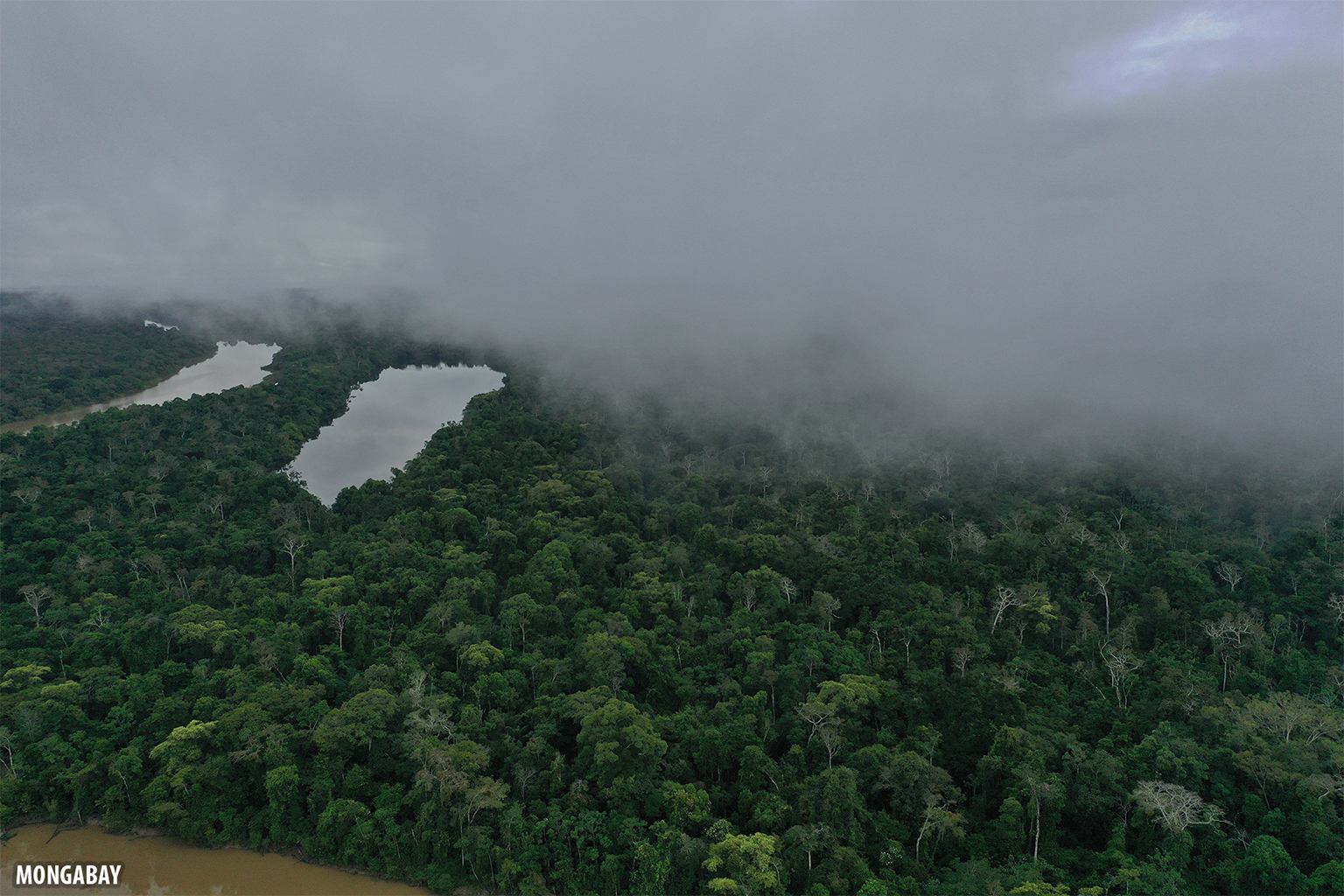
- Forests, increasingly looked to for their role in addressing climate change, can draw carbon from the atmosphere, but they also have more localized impacts on temperature and weather.
- Forests are responsible for about 0.5°C (0.9°F) of cooling globally when their ability to sequester carbon and these biophysical effects are considered, a recent study has found.
- Tropical forests, with their speedy uptake of carbon and the local cooling they provide — by humidifying the air, for example — are considered a “double win” for the climate.
As hot and muggy as most tropical rainforests are, you only need to leave their florid confines and step onto a recently razed plot of land to feel an immediate difference. In the bright sun, a wall of drier heat greets you, jolting your body with the impulse to return to the shade and humidity of the forest.
Forests — and tropical forests in particular — have garnered a lot of attention lately for the role they can play in dampening climate change. They mop up as much as a third of the carbon dioxide that we humans add to the atmosphere, mostly through the burning of fossil fuels. And yet, we’re continuing to cut them down at a terrifying clip.
“It’s been a triumph to get the public to recognize that CO2 is the problem, that fossil fuels are causing it, and that trees are part of the solution,” said Deborah Lawrence, an environmental scientist and professor at the University of Virginia in the U.S. “That’s a win.”
In a recent study published March 24 in the journal Frontiers in Forests and Global Change, Lawrence and her colleagues showed that, without forests, the global temperature would be around 0.5° Celsius (0.9° Fahrenheit) higher. Locking away climate-warming carbon in forests helps to keep a lid on temperatures. But Lawrence said that’s only part of the story. A suite of forests’ “biophysical mechanisms,” as scientists call them, also play a role, altering the temperatures and weather that we and other living things encounter on the ground.
For example, as trees draw water from the forest floor through their roots and up to the canopy in a process called evapotranspiration, it pulls heat away from the ground. While that heat doesn’t leave the global climate system, this process does impact the temperature in and around forests. Similarly, the way forests reflect or absorb sunlight, the chemicals they release and their contribution to cloud formation can make for wildly different sensations at Earth’s surface.

“We are at a point where every tenth of a degree matters,” Lawrence said. “The way we experience weather is affected by whether or not we have forests around us, and that has nothing to do with their CO2 effects. It has everything to do with their biophysical effects.”
At the 2015 U.N. climate conference in Paris, world leaders pledged to try to keep the global temperature rise at no more than 1.5°C (2.7°F) above pre-industrial levels in the mid-19th century. Scientists say achieving this goal will spare us from the worst ramifications of climate change. They figure the average temperature is currently about 1.1°C (2°F) higher than it was before industrialization.
“At this point, we would have had the experience of something past 1.5°[C] if we didn’t have our forests,” Lawrence said.
For the study, she and her colleagues pulled together past scientific research detailing these often-forgotten effects and how they ripple through the broader system. They combined those findings with an analysis of forest carbon stores from satellite data, and then they broke down their results by latitude.
Tropical forests are “a huge engine of cooling,” Lawrence said. By themselves, the researchers found, they keep the global average temperature down by nearly 1°C (1.8°F).
The study reveals “the importance of tropical forests,” said Yan Li, an associate professor of geography at Beijing Normal University in China. Li, who was not involved in this research, has studied the biophysical effects of forests, including how deforestation influences temperature and agriculture. He called the preservation of tropical forests a “double-win” for the climate because they both sequester large amounts of carbon and cool the surrounding area.
Having a refuge to which plants, animals and other life can retreat in a warmer world can boost the chances that they survive, Lawrence said.
“That’s a very big buffer for species, certainly,” Stephanie Roe, global climate lead scientist with WWF, told Mongabay. “It’s huge.”

That adaptation advantage extends to humans as well, whether they’re living in communities close to forests or in cities, said Roe, who was not involved in the study.
“It’s the reason why trees in urban areas and settlements, for example, are considered a nature-based solution,” she added, blunting the impact of climate change-driven heat waves and the heat island effect of cities’ concrete jungles.
The overall picture of forests’ effects became murkier, however, when they added boreal forests to the analysis. In these northerly forests, deforestation can actually lead to less warming than might otherwise be expected from the loss of carbon-extracting trees. Here, dark trees absorb energy from sunlight, warming their surroundings. When those forests are gone, it exposes the snow on the ground. Snow reflects more of the sun’s energy instead of absorbing it, leading to cooler temperatures locally — at least as long as the snow sticks around.
Christopher Williams, an environmental scientist and professor of geography at Clark University in the U.S., said the research tackles the sometimes thorny conclusions about forests.
“[The study’s] two most important takeaways are that we can safely declare that protecting humid tropical forests helps to cool the climate,” he said in an email, “but that this is not necessarily the case for higher latitude boreal forests.”
Williams, who wasn’t involved in the research, also noted that it would be helpful to include the impact of more arid regions of the planet, where the presence of forests can be a warming force.
“It is now well documented that some of the world’s forests contribute a net planetary warming, and these forests cannot contribute to climate change mitigation,” he said. Similar to the way snow or ice reflects more of the sun’s energy than darker boreal forests, he added, “Drylands typically have bright and reflective soils as well as bright and reflective grasses and herbaceous vegetation types, all of which are exposed in the absence of forest cover.”
Still, losing forests anywhere has the potential to notch up global temperatures, said William Schlesinger, the president emeritus of the Cary Institute of Ecosystem Studies in the U.S., who was not involved in the research.

“The important contrast is that carbon dioxide warms the whole planet pole to pole, year-round, and the more you have in the atmosphere, the warmer the planet will get,” Schlesinger said.
What’s more, preserving tropical forests is something that can be done right now to tackle climate change, Roe said.
She also noted that the inclusion of the biophysical mechanisms in forests in climate models could help guide countries’ decisions about climate change mitigation. She and her colleagues published a study in 2021 that broke down, country by country, the land-based approaches that could address climate change.
Despite the essential role of forests, Roe said, we need every available tool at our disposal to deal with climate change and minimize its worst repercussions as much as possible. Forests are only part of the answer, she added. Cutting the amount of carbon dioxide humans release through the burning of fossil fuels and activities such as agriculture is also critical.
“Forests and other ecosystems provide enormous service to climate change, both from a mitigation perspective and an adaptation perspective,” Roe said, “but they can’t do it all.”
Banner image: Tropical forests, with their speedy uptake of carbon and the local cooling they provide — by humidifying the air, for example — are considered a “double win” for the climate. Image by ancymonek via Adobe Stock.
John Cannon is a staff features writer with Mongabay. Find him on Twitter: @johnccannon
Citations:
Lawrence, D., Coe, M., Walker, W., Verchot, L., & Vandecar, K. (2022). The unseen effects of deforestation: Biophysical effects on climate. Frontiers in Forests and Global Change, 5. doi:10.3389/ffgc.2022.756115
Li, Y., Zhao, M., Motesharrei, S., Mu, Q., Kalnay, E., & Li, S. (2015). Local cooling and warming effects of forests based on satellite observations. Nature Communications, 6(1). doi:10.1038/ncomms7603
Roe, S., Streck, C., Beach, R., Busch, J., Chapman, M., Daioglou, V., … Lawrence, D. (2021). Land‐based measures to mitigate climate change: Potential and feasibility by country. Global Change Biology, 27(23), 6025-6058. doi:10.1111/gcb.15873
FEEDBACK: Use this form to send a message to the author of this post. If you want to post a public comment, you can do that at the bottom of the page.
Beyond CO2, tropical forests a ‘cool’ solution to climate crisis, study finds
Source: Trends News


0 Comments